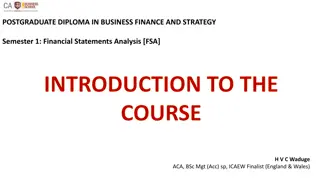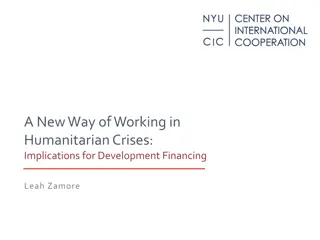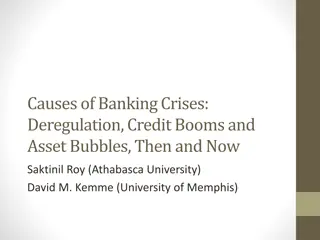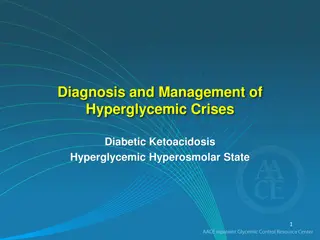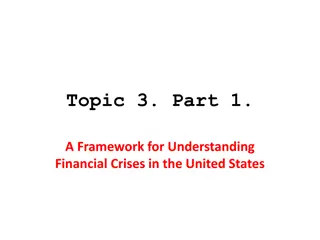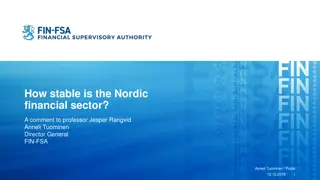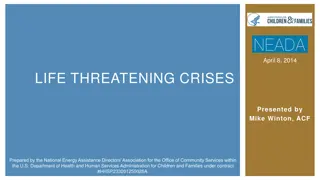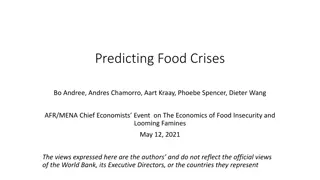Understanding Financial Crises and Their Impacts
Financial crises arise due to disruptions in financial markets, leading to severe economic consequences. This text delves into the definition, stages, causes, and effects of financial crises, with a focus on the global financial crisis of 2007-2009 and the European Sovereign Debt Crisis. It also discusses changes in financial regulation post-crisis and highlights gaps in current regulations that need addressing for future stability.
Download Presentation

Please find below an Image/Link to download the presentation.
The content on the website is provided AS IS for your information and personal use only. It may not be sold, licensed, or shared on other websites without obtaining consent from the author. Download presentation by click this link. If you encounter any issues during the download, it is possible that the publisher has removed the file from their server.
E N D
Presentation Transcript
Chapter 9 Why Do Financial Crises Occur (Why they occur and why they have such devastating effects on the economy.)
Learning Objectives Define the term financial crisis. Identify the key features of the three stages of a financial crisis. Describe the causes and consequences of the global financial crisis of 2007 2009. Summarize the changes to financial regulation that developed in response to the global financial crisis of 2007 2009. Identify the gaps in current financial regulation and how they might be addressed with future regulatory changes.
Global: The European Sovereign Debt Crisis The increase in budget deficits that followed the financial crash of 2007 2009 led to fears of government defaults and a surge in interest rates. The sovereign debt crisis, which began in Greece, moved on to Ireland, Portugal, Spain, and Italy. The stresses created by this and related events continue to threaten the viability of the euro.
What Is a Financial Crisis? A financial crisis occurs when there is a particularly large disruption to information flows in financial markets, with the result that financial frictions increase sharply and financial markets stop functioning.
Dynamics of Financial Crises Stage One: Initiation of a Financial Crisis Credit Boom and Bust: Mismanagement of financial liberalization/innovation drives down the net worth of banks and triggers the deleveraging process Asset-price Boom and Bust As the asset-price bubble burst, the net worth of companies declines, encouraging firms to make riskier investment Increase in Uncertainty
Dynamics of Financial Crises Stage two: Banking Crisis Deteriorating balance sheets may lead financial institutions into insolvency Savers withdraw their deposits and banks sell off assets to raise necessary funds The fire sales cause asset prices to drop again and more banks to fail Stage three: Debt Deflation As debt payments are fixed in nominal terms, an unanticipated decline in price level will raise the burden of the debt in real terms
Figure 1 Sequence of Events in Financial Crises in Advanced Economies
The Mother of All Financial Crises: The Great Depression How did a financial crisis unfold during the Great Depression and how it led to the worst economic downturn in the history of the United States and other advanced economies? This event was brought on by: Stock market crash Bank panics Continuing decline in stock prices Debt deflation
Figure 2 Stock Price Data During the Great Depression Period Source: Dow-Jones Industrial Average (DJIA). Global Financial Data: http://www.globalfinancialdata.com/index_tabs.php?action=detailedinfo&id=1165 .
Figure 3 Stock Price Indexes in a Selected Number of Advanced Economies, 1929 1931 Source: Adapted from Kindleberger, 1986, Figure 6..
The Global Financial Crisis of 20072009 (1 of 8) Causes of the 2007 2009 Financial Crisis: Financial innovations emerge in the mortgage markets Subprime mortgage Mortgage-backed securities Collateralized debt obligations (CDOs) Housing price bubble forms Increase in liquidity from cash flows surging to the United States Development of subprime mortgage market fueled housing demand and housing prices
The Global Financial Crisis of 20072009 (2 of 8) Causes (cont d): Agency problems arise Originate-to-distribute model is subject to principal- (investor) agent (mortgage broker) problem Borrowers had little incentive to disclose information about their ability to pay Commercial and investment banks (as well as rating agencies) had weak incentives to assess the quality of securities Information problems surface Housing price bubble bursts
The Global Financial Crisis of 20072009 (3 of 8) Effects of the 2007 2009 Financial Crisis The growth in subprime mortgage market increased demand for houses and so fueled the boom in housing prices After a sustained boom, housing prices in the U.S. and other countries (such as Ireland or Spain) began a long decline, starting in 2006. The decline in housing prices contributed to a rise in defaults on mortgages and a deterioration in the balance sheet of financial institutions. This development in turn caused a run on the shadow banking system.
The Global Financial Crisis of 20072009 (4 of 8) Origins: U.S. financial markets Crisis spreads globally Sign of the globalization of financial markets TED spread (3 months interest rate on Eurodollar minus 3 months Treasury bills interest rate) increased from 40 basis points to almost 240 in August 2007.
The Global Financial Crisis of 20072009 (5 of 8) Deterioration of financial institutions balance sheets: Write downs Sell of assets and credit restriction High-profile financial firms fail, in the U.S. and Europe In the United States: Bear Stearns (March 2008), Fannie Mae and Freddie Mac (July 2008), Lehman Brothers, Merrill Lynch, AIG, Reserve Primary Fund (mutual fund) and Washington Mutual (September 2008)
The Global Financial Crisis of 20072009 (6 of 8) High-profile financial firms fail, in the U.S. and Europe (contd.) In the United Kingdom: Northern Rock (September 2008), Royal Bank of Scotland (October 2008) Elsewhere: BPN (Portugal, November 2008), Anglo- Irish Bank (January 2009), the whole Icelandic banking sector (October 2008)
The Global Financial Crisis of 20072009 (7 of 8) Bailouts In the United States, Congress approved a $787 billion economic stimulus plan on February 13, 2009. In the United Kingdom, the government announced a 500 billion bank rescue package in October, 2008. Similarly, in countries such as Ireland, Spain, Belgium, and the Netherland, large scale rescue plans were announced to bail out ailing banks.
The Global Financial Crisis of 20072009 (8 of 8) Height of the 2007 2009 Financial Crisis The stock market crash gathered pace in the fall of 2008, with the week beginning October 6, 2008, showing the worst weekly decline in U.S. history. Surging interest rates faced by borrowers led to sharp declines in consumer spending and investment. The unemployment rate shot up, going over the 10% level in late 2009 in the midst of the Great Recession, the worst economic contraction in the United States since World War II. Political consequences: electoral defeat of incumbent governments (Iceland, UK), unrest, increased polarization
Government Intervention and the Recovery Short-term Responses and Recovery Financial Bailouts: In order to save their financial sectors and to avoid contagion, financial support was provided by many governments to bail out banks, other financial institutions, and even the so-called too-big-to- fail firms that were severely affected by the financial crisis. Fiscal Stimulus Spending: To boost their individual economies, most governments used fiscal stimulus packages that combined government expenditure and tax cuts.
Stabilizing the Global Financial System: Long-Term Responses With the individual emergency national bailouts to rescue national economies and financial sectors, global leaders looked to building a more stable and robust global financial system. Steps taken by governments included Implement sound macroeconomic policies Enhance their financial infrastructure Develop financial education and consumer protection rules Enact macro- and microprudential regulations.
Long-Term Responses (contd.) At the international level proactive globally-binding supervision was designed financial market discipline enforced systemic risk managed To avoid collective action problems and to ensure that policy actions are mutually consistent with national growth objectives, aggregate plans began to be drafted simultaneously. The first ever of these is the Mutual Assessment Process (MAP) launched in 2009 by the G20.
Dynamics of Financial Crisis in Emerging Market Economies (1 of 5) Stage one: Initial Phase Path A: Credit Boom and Bust Weak supervision and lack of expertise lead to a lending boom. Domestic banks borrow from foreign banks. Fixed exchange rates give a sense of lower risk. Banks play a more important role in emerging market economies, since securities markets are not well developed yet. At this stage emerging economies may report sound fundamentals. For example, fiscal positions may be sound. Credit boom is associated with deteriorating balance of payments.
Dynamics of Financial Crisis in Emerging Market Economies (2 of 5) Stage one: Initial Phase Path B: Severe Fiscal Imbalances Governments in need of funds sometimes force banks to buy government debt. When government debt loses value, banks lose and their net worth decreases. Additional factors: Increase in interest rates (from abroad) Asset price Decrease firms' net worth and thus increase adverse selection problems Uncertainty linked to unstable political systems
Dynamics of Financial Crisis in Emerging Market Economies (3 of 5) Stage two: Currency Crisis Deterioration of bank balance sheets triggers currency crises: Government cannot raise interest rates (doing so forces banks into insolvency) and speculators expect a devaluation. Note difference with advanced economies (where bank failures do not cause currency crisis) Severe fiscal imbalances triggers currency crises: Foreign and domestic investors sell the domestic currency.
Dynamics of Financial Crisis in Emerging Market Economies (4 of 5) Stage three: Full-Fledged Financial Crisis Currency mismatch: another difference from advanced economies Arises out of the denomination of many debt contracts in a foreign currency (usually a foreign reserve currency such as the US$) At the same time, however, domestic income denominated in local currency With currency crisis, firms face a higher debt Net worth decreases and averse selection problems increases
Dynamics of Financial Crisis in Emerging Market Economies (5 of 5) Stage three: Full-Fledged Financial Crisis Debt burden in terms of domestic currency increases (net worth decreases). Increase in expected and actual inflation reduces firms cash flow. Twin crisis Banks are more likely to fail: Individuals are less likely to payoff debts (value of assets fall) Debt denominated in foreign currency increases (value of liabilities increase)
Figure 1 Sequence of Events in Emerging Market Financial Crises
Preventing Emerging Market Financial Crises Beef up prudential regulation and supervision of banks Encourage disclosure and market-based discipline Limit currency mismatch Sequence financial liberalization





